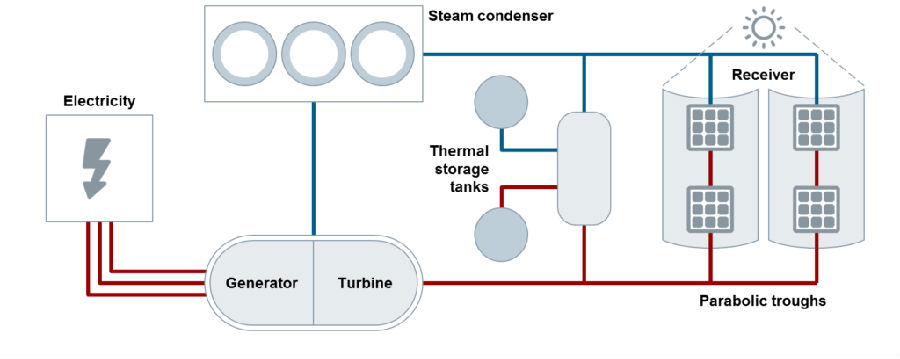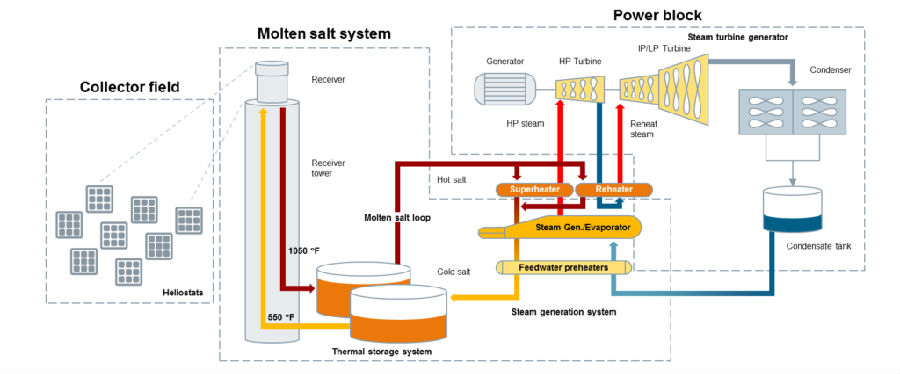Home > Market > Other Regions > Here
Concentrated Solar Power (CSP) – from niche to winning technology (1)
2019.02.15 From: Siemens
Concentrated Solar Power (CSP) plants initially won their place on the market thanks to government subsidies. Current trends reveal, however, that development efforts have meanwhile pushed this technology in combination with photovoltaic (PV) installations to competitive parity with fossil power generation.
Part 1: CSP – technology on its way to maturity
Part 2: CSP – all signs pointing to a breaktrough
Pioneer plants remained niche applications
The use of solar energy to generate electric power is by no means an invention: a solar-thermal power plant had been built in Egypt as early as 1912, and a larger number of CSP plants were erected in the United States back in the 1970s and 80s. These installations all proved that it’s fundamentally possible to generate electricity from solar power, and that such systems function reliably. Yet, two key factors in that era still impeded widespread acceptance of solar-thermal power generation: the lack of means at that time for storing energy, and the excessively high generating costs of CSP compared to fossil fuel power plants. Consequently, CSP plants remained a niche application for the time being.
Environmental awareness boosts marketability
As awareness grew over time – particularly among the world’s industrialized nations – that our fossil fuel reserves are not infinite and that combustion of fossil fuels is one of the main causes of climate change, the post-millennial years saw renewed initiatives to advance the development of CSP technologies. In particular Spain and the United States seized the reins as pioneers driving these new efforts. Motivated by state-backed subsidization programs that ensured CSP plant operators adequate grid feed-in tariffs, over 70 concentrated solar-thermal power plant projects were built between 2005 and 2012, delivering a total electrical generating capacity exceeding 4 gigawatts (GW). Spain stands out especially, with more than 40 installed CSP plants generating over 2 GW in total. Various general conditions are typically specified for such incentivizing programs. In Spain, for example, the electrical generating capacity per power plant was limited to a net grid feed-in volume of 50 megawatts (MW). Most of these installations were based on parabolic-trough technology, in which thermal oil is used as a heat-transfer fluid, heated to high temperatures as it is routed through a tube running along the focal line of parabolic mirrors. This heat is then used to generate steam in a heat exchanger, which in turn drives a downstream steam turbine-generator set to produce electric power. While the properties of this thermal oil initially limited the resultant main steam temperatures to less than 400°C, new heat-transfer oils have meanwhile been developed that enable main steam temperatures of up to 435°C. Almost all CSP plants are also designed with a reheat system to increase the efficiency of the water-steam cycle even further.

Scheme of a Parabolic Trough CSP Plant
A winning technology gains acceptance
Hence, the following general requirements profile was defined for turbine manufacturers supplying Spain’s CSP plants:
Relatively small volumetric flow (50 MW per unit)
Low inlet parameters (main steam temperature < 400°C, main steam pressure 100 bar)
Inclusion of reheat system, and plant startup and shutdown daily.
Siemens succeeded in offering the most convincing solution for these needs with its dual-casing steam turbine in which the high-pressure turbine is designed as high-speed geared unit. All told, 37 of the 47 Spanish CSP plants have been outfitted with a Siemens turbine-generator set.
Central Tower applications as enabler for higher efficiency
In contrast, different framework conditions in the United States, South Africa and India allow CSP plants with unit outputs exceeding 100 MW. What’s more, initial solar power tower projects utilizing central receiver tower (CT) technology are being implemented in addition to parabolic-trough (PT) configurations. CT technology makes use e.g. of molten salt as heat-transfer fluid, which is heated in a receiver atop a tower by concentrated sunrays focused by an array of tracking heliostat reflectors (i.e. large adjustable mirrors).
Central solar tower technology offers two important advantages: Not only can higher main steam conditions be achieved, currently up to 180 bar at 565°C, which significantly increases the efficiency of the water-steam cycle, but the heated salt can also be stored in tanks for periods of up to several hours. This creates for the first time a means of economically storing large quantities of solar energy in a useful, reproducible form, and of feeding that energy as electricity to the power grid as demand dictates. While thermal storage by means of molten salt requires inclusion of additional equipment, it offers decisive, noteworthy advantages over energy storage in batteries – such as the current capacity of 110 MW for 1,100 MWh of power, and the planned 200 MW for 2,000 MWh, each with 10 hours storage time. Equipping and operating this thermal energy storage system is far more economical than storing electricity in batteries, and the system service life is longer by many times over.

Scheme of a Central Tower CSP Plant
Parabolic-trough solar power plants have also been fitted with molten-salt energy storage systems, some even before central power towers were ever constructed.
Owing to the higher theoretical efficiency of solar power towers, the idea prevailed for a time that PT projects would eventually be replaced with tower configurations. This assumption neglected to consider, however, that local conditions can differ. In regions with high dust particle concentrations due e.g. to sand storms, experience has shown that the large distance between the reflectors and receiver, such as in central tower units, poses disadvantages. In such settings, PT installations prove more economical despite the disadvantage of the lower main steam temperature. In areas where pristinely clear atmospheric conditions prevail, tower installations can be used to their full advantage. Both technologies will therefore remain important options.
Upcoming CSP events:
9th Annual CSP Focus China 2019(Mar.21-22, Beijing)
4th Annual CSP Focus MENA 2019(Jun.26-27, Dubai)
More CSP news and reports please visit www.cspfocus.cn
More from CSP Focus
NextLiping JIANG: Improving the sustainability of high percentage new energy power systems
Dubai CSP suppliers tested on durability for longest-ever PPA (35 years)
Solar spectral network (SSN) in Armenia and Canada based on SEMS-2000/3000
SEPCO3 and BAOWU signed the EPC contract of Tibet Zabuye Integrated Energy Supply Project
Concentrated solar power tower exposes materials to intense heat to test thermal response
China Silk Road Fund acquired 24.01% equity interest of Dubai DEWA 700MW CSP project
South Africa eyes CSP heating, cooling applications on back of power program
Leave your thoughts here
Reports(Member Only)
See more+-
CSP Focus Membership Proposals
We are now proposing CSP Focus Membership, hoping to better serve our members to keep pace with the latest updates of ongoing CSP projects worldwide, and to establish and maintain business relations with major shareholders of the projects. CSP Focus offers to Membership exclusive access to:1. Daily/Weekly update and analysis on CSP policies, projects, technologies, market trend and corporate relea
-
The Latest CSP Focus Monthly Update
Join CSP Focus Membership to Get the Latest CSP Focus Monthly Update December Edition.
-
CSP Project Monthly Update 2022 December Edition
CSP Focus is presenting CSP Project (China) Update 2022 December Edition.Detail report is available for CSP Focus Membership.
-
Presentations-CSP Focus China 2021
The Report is for CSP Focus Members only.
Upcoming Events
See more+-
12th CSP Focus China 2022
2022.04.21-22 Beijing
-
11th CSP Focus China 2021
2021.10.28-29 Beijing
-
10th CSP Focus China 2020
2020.10.22-23 Beijing, China
Project Updates
See more+-
Lanzhou Dacheng Dunhuang CSP Project
Asia Pacific-China,Operational,Parabolic Trough
-
Luneng Haixi 50MW Molten Salt Tower CSP Project
Asia Pacific-China,Operational,Power Tower
-
Dubai 950MW NOOR Energy 1 CSP+PV Project
MENA-UAE,Under construction,Power Tower
-
Power China Gonghe 50MW Molten Salt Tower CSP Project
Asia Pacific-China,Operational,Power Tower





